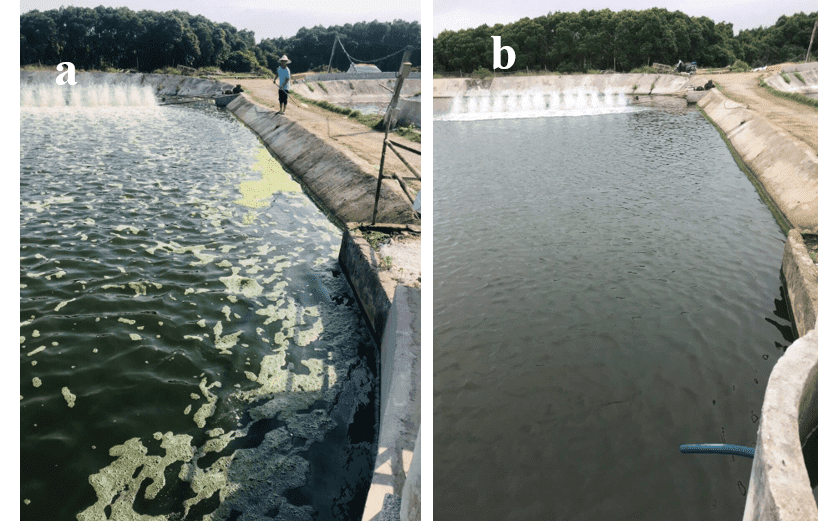7 TREATMENT MEASURES TO DEAL WITH TOXIC ALGAE
Toxic
In the Aquaculture industry, especially in shrimp farming, algae is an important element in the natural food chain and serves as a biological filtration system that helps to balance environmental factors. However, if toxic algae overgrow or lack algae will cause changes in the water environment and adversely affect shrimp health. In this article, we will find out what is the reason for the formation and development of these toxic algae. At the same time, Thai Nam Viet company will also offer solutions to help farmers prevent toxic algae effectively, contributing to ensuring the productivity of the farming crop.
Reason
- Algae growth at the beginning of the crop is usually due to poor pond improvement, dirty pond bottom, accumulation of many organic substances, and organic pollution of the supply water.
- During the farming process, there are many causes of algae overgrowth:
- Organic pollution: excess feed due to poor management of feeding, waste from shrimp.
- The weather changes erratically: prolonged rain reduces salinity, and stratification of the water surface creates favorable conditions for blue-green algae to grow. When the weather is hot for a long time, the increase in water temperature will promote the decomposition of organic sludge, creating more nutrients to help algae grow strongly.
Harm
Besides beneficial algae for shrimp farming, the overgrowth of toxic algae such as blue-green algae, thyroid algae, red algae, etc. will directly or indirectly affect shrimp. These algae will secrete toxins that adversely affect water quality, affecting the hepatopancreatic and digestive systems if eaten by shrimp, leading to a weakened immune system that makes shrimp susceptible to pathogens and other diseases.
Making shrimp sick because of white feces disease due to eating cyanobacteria but not digesting, causing bad odor for shrimp, causing oily water, slime discharge that clogs shrimp gills, and obstructing respiration. Granules or cyanobacteria are equally toxic, but filaments are often more toxic due to entanglement and gills, and shrimp are often ingested but not digested.
If eaten by shrimp, it will make shrimp difficult to digest, affecting the digestive system, suffering from segmental disease, which is the cause of shrimp floating at night due to lack of oxygen. In addition, the algae are also the cause of the glowing phenomenon in the pond.
As an environmental indicator, when the algae appear excessively, it shows that the pond is organically polluted and the pond bottom is dirty.
Produces toxins that cause paralysis, poisoning, and neurotoxicity, damaging or blocking the gills of shrimp and fish. Red algae also make shrimp float at night and early in the morning due to lack of oxygen in the water, causing the glowing phenomenon and seriously affecting the survival behavior of cultured shrimp.
The development of toxic algae severely affects the yield of the crop. Photo: Unsplash
How to effectively treat toxic algae
- Remove dead algae and change the water to reduce the density of algae, however, this solution is very laborious and expensive.
- Good management of feeding is to control excess feed in the pond.
- Treat the bottom (suction sludge and siphon) regularly to limit the accumulation of organic matter at the bottom of the pond
- Algae cutting by night lime with permissible dose (with zeolite, regular suction, and siphon), BKC, CuSO-based algaecide
- For blue-green algae, a measure of increasing salinity can be applied by adding water or adding salt 10kg/1000m 3 hanging at the tip of the propeller.
- Stocking tilapia with shrimp in ponds, because tilapia usually live in the middle and bottom layers, they can consume 30-60% of the protein in the algae, especially blue-green algae, and green algae to help stabilize the quality. amount of water.
- Probiotic supplements:
- Enzyme preparations: Cellulase, Protease, Amylase… to help cut algae quickly.
- Microbiological products: strains of beneficial bacteria Bacillus spp. capable of decomposing excess organic matter, and secreting enzymes to cut algae. Supplementing with probiotics in combination with good water and feed quality management can stabilize the algae density in the pond, helping aquatic animals grow healthy.
Proposed solution of Thai Nam Viet Company
The use of biological products in the Aquaculture industry is currently a trend chosen by many farmers, these products not only solve the problem effectively, quickly, safely but also friendly. environment, ensuring the sustainable development of the fisheries sector. THAI VIETNAM CO., LTD has developed two lines of biological products to thoroughly and safely solve the problem of toxic algae in ponds.

WD 103
Microbiological products specializing in the treatment of algae in ponds, with bacterial species such as: Bacillus subtilis, Bacillus lichenifomis, Bacillus amyloliquefaciens …
PROCOZOLL
A synthetic form of 5 enzymes: Protease, Amylase, Cellulase, Lipase, Urease, helping to control toxic algae and organic sludge


The effectiveness of PROCOZOLL
- The shrimp pond has too many blue-green algae
- Shrimp pond after 3 days of using algae-cutting enzyme






